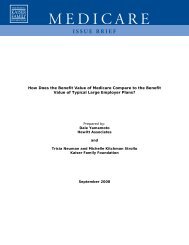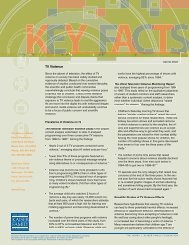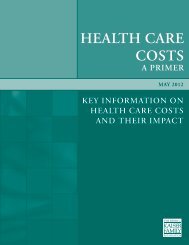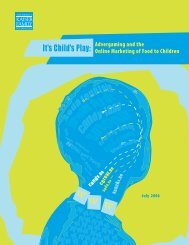Sex Ed Issue Update.indd - The Henry J. Kaiser Family Foundation
Sex Ed Issue Update.indd - The Henry J. Kaiser Family Foundation
Sex Ed Issue Update.indd - The Henry J. Kaiser Family Foundation
You also want an ePaper? Increase the reach of your titles
YUMPU automatically turns print PDFs into web optimized ePapers that Google loves.
State Policy<br />
Despite these federal eff orts, education policy is mostly<br />
decentralized. And, since states may have multiple policies<br />
governing the teaching of sex education, the overall policy<br />
picture is fairly complex. For example, states that require that<br />
sex education be taught may vary considerably in terms of<br />
what, if any, curriculum they specify. Meanwhile, a state that<br />
has no specifi c policy on sex education may still “recommend”<br />
that educators take a particular course of action or even specify<br />
that a school district opting to off er sex education adhere to a<br />
particular curriculum.<br />
Even within an individual state, there may be diff ering policies<br />
governing mandates for education about contraception or<br />
abstinence and instruction on HIV/AIDS and other STDs. In<br />
fact, more states require schools to off er specifi c HIV or STD<br />
education than general sex education. It is also common for<br />
states to have diff erent requirements for students in diff erent<br />
grade levels. <strong>The</strong>se policy distinctions among and within states<br />
are often lost in the larger debate about sex education.<br />
As of September 2002, 22 states require that students receive<br />
sex education and 39 require HIV/STD instruction: 15<br />
• Twenty-two (22) states require schools to provide both<br />
sex education as well as instruction on HIV/STDs (AK,<br />
DE, FL, GA, HI, IL, IA, KS, KY, ME, MD, MN, NV, NJ, NC, RI,<br />
SC, TN, UT, VT, WV, WY).<br />
• Seventeen (17) states require instruction about HIV/<br />
STDs, but not sex education (AL, CA, CT, ID, IN, MI, MS,<br />
NH, NM, NY, ND, OH, OK, OR, PA, WA, WI).<br />
• One state requires sex education, but not STD<br />
instruction (ME).<br />
Specifi c requirements about what should be taught are also<br />
on the books in a number of states. Thirty (30) states require<br />
local school districts that off er sex education to teach about<br />
abstinence: Eight require that it be covered (CT, DE, FL, GA, KY,<br />
MI, VT, VA) and twenty-two require that it be stressed (AL, AZ,<br />
AK, CA, HI, IL, IN, LA, MD, ME, MS, MO, NC, NJ, OK, OR, RI, SC, TN,<br />
TX, UT, WV). In addition, thirteen of these states require local<br />
school districts that do off er sex education to cover information<br />
about contraception (AL, CA, DE, HI, MD, MO, NJ, OR, RI, SC, VT,<br />
VA, WV), but no state requires that birth control information be<br />
emphasized.<br />
Thirty-four states (34) give parents some choice as to whether<br />
or not their children can receive sex education or STD<br />
instruction (AL, AZ, CA, CT, FL, GA, ID, IL, IA, KS, LA, MD, MA,<br />
ME, MI, MN, MS, MO, MT, NJ, NY, NC, OK, OR, PA, RI, SC, TN, TX,<br />
VT, VA, WA, WV, WI). 16 Most of these states give parents the<br />
option of withdrawing their children from the courses. Three of<br />
these states (AZ, NV, UT) say that parents must actively consent<br />
before the instruction begins, while one of these (AZ) has an<br />
opt-out policy for STD education while requiring parental<br />
consent for sex education. Of the states with “opt-out” policies,<br />
fi ve require that it be due to a family’s religious or moral beliefs.<br />
Local Policy<br />
Even when state policy on sex education exists, signifi cant<br />
latitude and oversight is left to local school districts. 17 A<br />
national survey of school superintendents, conducted in 1998<br />
by the Alan Guttmacher Institute (AGI), found that more than<br />
two-thirds (69%) of U.S. school districts have a policy to teach<br />
sex education. 18 <strong>The</strong> remaining 31 percent leave the decisions<br />
about whether to teach such curriculum to individual schools.<br />
However, a disproportionate number of students reside in the<br />
districts with policies to teach sex education.<br />
Among districts with a policy, 14 percent report that their<br />
policy takes a “comprehensive” approach, teaching abstinence<br />
as one possible option for adolescents; 51 percent promote<br />
“abstinence-plus,” that is abstinence as the preferred option but<br />
allowing discussion of contraception as eff ective in protecting<br />
against pregnancy and disease; and the remaining third (35%)<br />
have an “abstinence-only” policy.<br />
When asked to name the single most important factor<br />
infl uencing district policy, an average of 48 percent of<br />
superintendents cite state directives. Special committees and<br />
school boards were named as infl uential about equally often<br />
(18% and 17%, respectively).<br />
Similarly, the large majority of public secondary school<br />
principals (88%) in the 1999 <strong>Kaiser</strong> <strong>Family</strong> <strong>Foundation</strong> study<br />
report that school districts and local governments have at least<br />
“some infl uence” on their schools’ sex education curricula. 19<br />
Seventy percent (70%) report that state government has at<br />
least “some infl uence,” and 31 percent report that the federal<br />
government’s abstinence-only funds had at least “some<br />
infl uence” at the time the survey was conducted. Principals<br />
also note that the content of sex education in public secondary<br />
schools is subject to at least some local or state guidelines<br />
(85%), including four in 10 principals (43%) who term the<br />
guidelines as “strict.”<br />
When a specifi c topic is not taught in sex education, principals<br />
often cite a school or district “policy.” For example, the leading<br />
reason given by principals for not covering abortion and sexual<br />
orientation was a school or district “policy,” followed closely by<br />
actual or perceived pressure from the community.<br />
Community Involvement<br />
Beyond government policy and public offi cials, principals<br />
report that several other groups are involved in deciding what<br />
is covered in their schools’ sex education curricula. More than<br />
half of principals (57%) say teachers are “very involved” and<br />
one in four (23%) say parents are as equally involved. Other<br />
members of the community (15%) and religious leaders (11%)<br />
are less frequently named.












